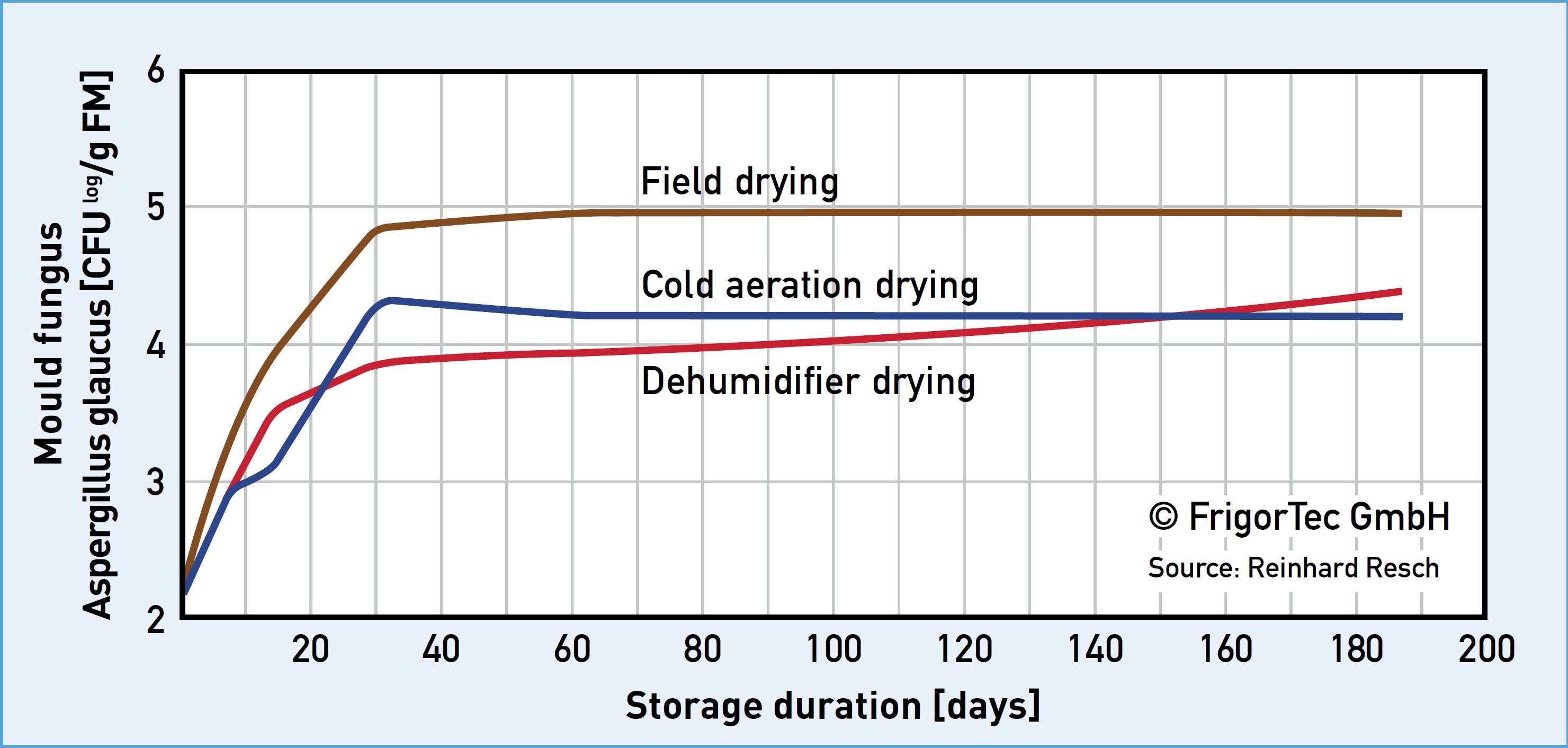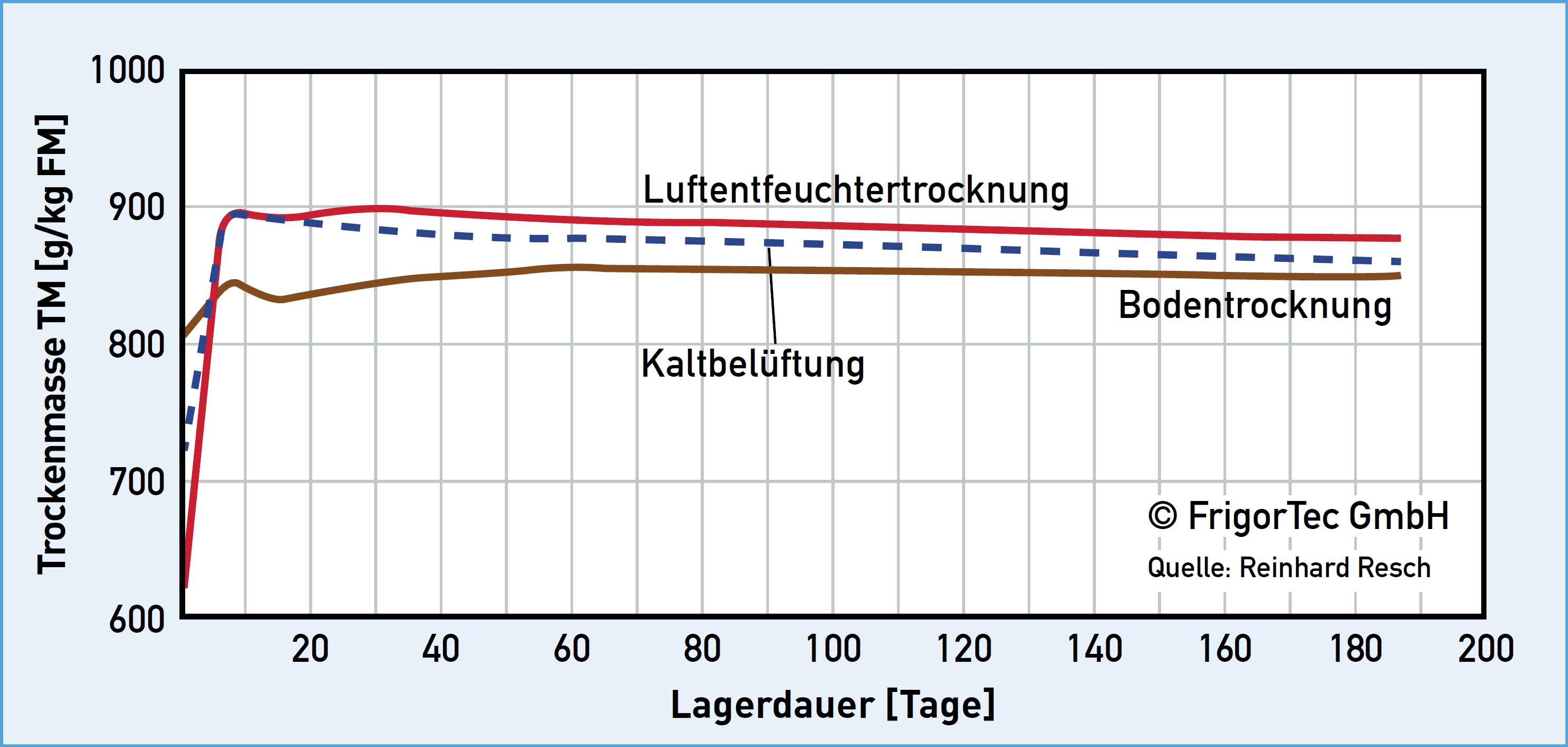Technical hay drying and its advantages
Better planning and quality assurance, more flexibility, independence from weather conditions, less risk of fire, and increased profitability: There are numerous reasons why farmers and operating companies invest in ultra-modern technical hay drying plants, with heat pump, and air dehumidifier.
Disadvantages of traditional hay drying methods
There are basically two types of traditional hay drying methods: ground drying and scaffold drying. While the hay drying process via scaffold drying is very labour-intensive and hardly used any more, ground drying is still widely used, but has some significant disadvantages. A particular challenge here are the crumb and flake losses that occur when drying fodder plants, especially legumes (lucerne, clover), on the ground. This results on the one hand from the tearing off of plant parts - caused by mechanical processing by hay tedders and rakes - and on the other hand from the degree of drying. The flakes are mainly leaves and buds, which contain important nutrients. If the hay is too dry, the flakes fall to the ground between the stubble and can no longer be picked up by machines such as balers or loading vehicles. With round baling, there is an additional loss of up to 2.6% of flake material.
Mould reduces hay quality to the point of spoilage
In addition to the loss of crumbs and flakes, mould infestation of ground-dried hay is a serious problem. This is shown by the micro-biological tests carried out by the Agricultural Research and Education Centre Raumberg-Gumpenstein (source: Resch R. (2014), Top-Heu dank Belüftungstrocknung (Top hay thanks to aeration drying), Allgäuer Bauernblatt 27/2014). Moulds such as Aspergillus glaucus and Wallemia sebi reproduce more strongly in ground-dried hay than in technically dried hay, and can cause spoilage within a short time. Indicators for mould-infested hay are dust and a musty smell. Moreover, weather is and remains the main risk in hay production. There is no guarantee of reliable sunny days in the right time period. Changeable or humid weather has a negative effect on hay yield and quality when drying on the ground. If a company has a technical hay drying plant, mowing or harvesting can be done up to 20 days earlier (source: Resch R. (2014), Top-Heu dank Belüftungstrocknung (Top hay thanks to aeration drying), Allgäuer Bauernblatt 27/2014). This makes companies efficient, weather-independent and flexible. They can use shorter times when the sun is out for wilting, and have better planning and quality assurance.

The difference between various drying methods on the development of the mould fungus Aspergillus glaucus (2)
Test winner "Technical hay dryer"
The Agricultural Research and Education Centre (LFZ) in Raumberg-Gumpenstein, Austria, investigated the three most common hay drying methods: traditional ground drying, fan-operated chilled air ventilation, and technical air dehumidifier drying. The result: A technical hay drying plant combined with roof extraction (under-roof preheating or solar preheating) offers many advantages over the two other methods. The LFZ test found that modern hay drying technology with a heat pump or dehumidifier leads to more dry matter, more net energy lactation, an average of 5 g more crude protein in the dry matter, and better digestibility of the organic matter.

Influence of different drying methods on the dry matter content DM (2)
Spontaneous combustion - a risk for hay
When drying hay, one risk to safety must never be overlooked: spontaneous combustion. Self-combustion can always occur if the drying process is stopped too early. This is because a residue of cells continue breathing for a long time in hay, e.g., in the stalks. The higher the residual moisture, the faster bacteria can multiply. Their metabolism causes the temperature in the hay to rise even further. Chemical degradation reactions take place among the pectins present in the cells. Pectins are vegetable polysaccharides, also known colloquially as multi-sugars. This leads to heat accumulation, which is further favoured by the poor thermal conductivity of hay. The result is: The temperature in the hay rises over time to 250°C, a critical temperature where self-combustion can occur. In principle, there is a risk of self-combustion if the hay is stored in bales. To reduce this risk to a minimum, it is essential to dry hay using a technical hay drying plant.
Better hay - more profitability
For dairy farmers in particular, good milk quality and quantity is of great economic importance, and this largely depends on feed quality. Professional hay drying with a technical hay drying plant leads to better quality hay and a maximum hay yield. At a time when prices for concentrated feed, especially protein concentrated feed, continue to rise, farms with self-produced hay can save money and increase their profitability.
Our products
More know-how articles
Designed to meet requirements as the basis for economical hay drying
Hay drying plants can be integrated into new buildings as well as into existing barns. In order for farmers to fully exploit the advantages of effective and at the same time energy-efficient hay drying, numerous individual factors must be taken into account when designing the plant.
Quality in quantity – professional hay and plant drying
Good hay quality is no coincidence, rather it comes from making the right decisions. There are clear definitions and guidelines that go into evaluating hay quality. We cannot influence weather conditions, so the use of a technical hay drying plant is nowadays indispensable for a high quality hay yield.
How hay quality affects animal health
Anyone who keeps farm animals knows the relationship between good hay and general animal health. Good hay stimulates ruminant animals, e.g., cows and goats to ruminate. It promotes grazing behaviour with the rumen, prevents metabolic diseases, and has a positive effect on milk yield and quality.
Arrange a consultation appointment
Our experts will be happy to advise you on the planning and implementation of your projects. Together we will find a perfect customised solution.
Arrange an appointment